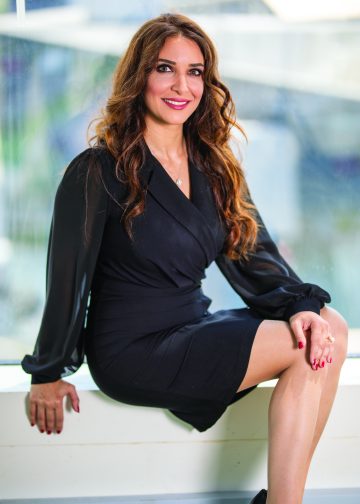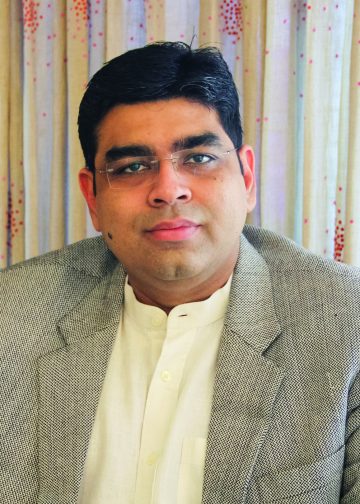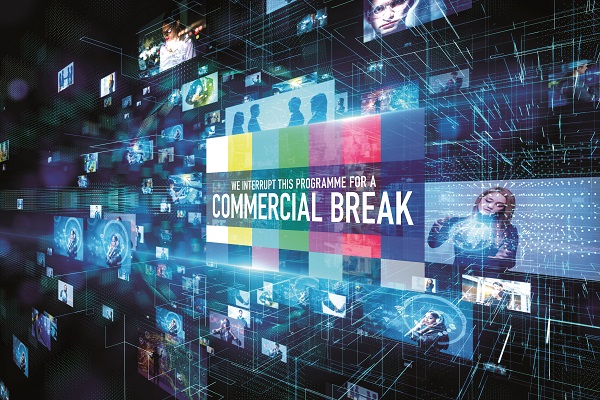‘Gone are the days of linear’ used to be the conversation. With the growth of FAST, will the conversation now be the reinvention of linear? A recent panel hosted by BroadcastPro ME explored the wave sweeping the media world. Sarah Nathan reports.
In recent years, the growth of streaming platforms and the tentative future of linear have been discussed extensively. Taking the stage now is FAST – a marriage of the two concepts. Exploring the FAST model, its monetisation opportunities and its place in the Middle East were Manoj Mathew, Territory Head of Zee Network Middle East, North Africa, Pakistan and Turkey; Sanjay Raina, Global Media & Entertainment Professional and StartUp Advisor; and Zahra Zayat, Chief Commercial Officer at evision by e& life (one of the specialist business pillars of e&, formerly known as Etisalat Group), in a panel moderated by Sumit Suri, Managing Director of U-TO.
What is FAST?
Quickly gaining traction, Free Ad-supported Streaming Television combines the experiences of linear TV and streaming platforms. FAST allows viewers to access content for free by leveraging advertising revenues to support its service.
Zayat described it as the revival of linear channels and traditional TV: “Consumption behaviour on traditional linear TV is dropping significantly. FAST has come as a solution to breathe life back into that traditional TV experience.” She also pointed out that FAST covers multiple verticals and can be extremely niche. “If we’re talking about cooking, FAST can focus on desserts. If we’re talking about movies, it could focus on certain genres, like action.”

Mathew characterised FAST as a tactical move by FTA operators to infiltrate the world of streaming. “Technically, FAST is a way of monetising free linear channels and free content which was previously on a satellite, on a streaming platform. It’s a mode of content monetisation which linear people have found out about and are now stepping into the streaming space with.” He added that it is an obvious technological successor: “We all feel technology is a disruptor; it is a disruptor only for the business it controls, but for the larger audience for whom we are trying to create an ecosystem, it is absolutely an enabler.”
Raina pointed out that FAST could be the solution for streaming businesses seeking new ways to make money, especially amid projections that platforms are unlikely to host over 1.4bn subscribers globally by 2027. “The struggle platforms are facing is making money. There is an ARPU issue; in a streaming business, you’re not making more than $7 or $8 on average.”
FAST is also slowly reinventing the notion that younger generations have lost contact with traditional linear TV, said Zayat. While streaming has primarily appealed to younger generations and linear TV has retained older people, the hybridity of FAST has attracted a range of age segments, especially young adults. Raina views FAST as an opportunity to put TV remotes back in the hands of young adults, much needed in the region. “Your linear business is supposed to attract both advertising and a younger audience, who are already quickly abandoning ship. If business doesn’t move and cut across to younger audiences, that’s a big problem, especially in this part of the world.”
How to run FAST
FAST is effective in retaining viewers aged 18-34, but Raina pointed out that this success is contingent on quality of content. Commending Pluto for its efforts, he said: “FAST service has worked on Pluto TV because the quality of content is amazing and has been utilised by an 18-to-34 audience. Content has to address those aged 18 to 34, both males and females, to give them the propensity to come back to television. A FAST platform in this part of the world has to be very audience-driven.”
He also explained how FAST may prosper in markets resembling India’s, where consumption of homegrown content and quality of content are both very strong, and questioned whether the quality of FTA content in the region is acceptable. “The Middle East is some miles away. We are very good at importing formats, but how many formats go out from this part of the world?”

Zayat agreed that content is the key to driving engagement. Because FAST attracts viewers of all ages, the objective should be “a relevant portfolio of FAST channels that cover the different segments that we are serving, supported by a line-up of on-demand content”. Besides showing increasing signs of subscription fatigue, consumers in the region are usually unwilling to pay. This amplifies the call for high-quality content and channels. “The channels have to be relevant enough for the segment we are serving,” she said, adding that FAST can also be helpful in repurposing content. “It brings back to life unexploited on-demand content which people have forgotten about but is actually really attractive.”
Raina and Mathew agreed that sports is a category ready for FAST. Sports fans often turn to YouTube or Instagram to catch highlights of the latest matches, even after watching live coverage. To leverage FAST effectively, Mathew said that repurposing content could retain viewers. “Can we create a FAST environment where a viewer would come back to see used content? Can we put something on FAST channels and keep viewers in this ecosystem? We’re trying to fight viewers going across to completely different social media platforms.”
Content in general entertainment can also be repurposed to retain viewers; for instance, FAST channels could show the funniest moments in comedies or the best sequences in action films.
Advertising on FAST
With the gradual decline of traditional TV comes advertisers’ reluctance to run campaigns on linear channels without being able to track performance. Zayat has observed first-hand that generally linear channels have lost their appeal to advertisers and believes FAST might be a good opportunity to uplift advertising performance. “A lot of advertisers will tell you that advertising on linear is no longer part of their marketing strategy. The willingness to pay for advertising on traditional linear TV has dropped significantly. The introduction of FAST might be a good opportunity to bring advertisers back to the table to reach audiences.”
“Consumption behaviour on traditional linear TV is dropping significantly. FAST has come as a solution to breathe life back into that traditional TV experience” – Zahra Zayat, Chief Commercial Officer at evision by e& life
FAST allows companies to track audiences and viewership, which benefits all parties involved, said Raina. “You can feel the click, you can see the audience, and you can follow the trail. You can know who is and isn’t watching, unlike linear television.” However, Mathew pointed out that the success rate of call-to-action advertisements on both linear and digital channels is under 5%. Unless ads are brand campaigns, viewership statistics may ultimately be of little use.
Accompanying the benefits of FAST advertising is the matter of whether advertisers should be charged higher CPMs. Zayat believes it ultimately depends on the scalability of FAST. “Today, you’re competing with social media and programmatic advertising. FAST presents a similar opportunity for advertisers to track and launch their marketing campaigns. It depends on its ability to scale to reach audiences that are relevant and fit for that specific campaign, whether it is awareness or conversion.”

However, Raina highlighted a unique benefit of FAST that programmatic advertising cannot offer. Referring to the latter as “a crass violation of advertisers’ money”, he explained that ads may end up on obscure, rarely accessed websites and fail to build an audience. “In a FAST service, you’re in a finite zone with a finite number of channels on a platform.”
Advertisers seeking viewership sit on one end of the boardroom table; customers seeking high-quality content sit on the other. Mathew pointed out that the sign of great advertising is storytelling: “Advertising is content in and of itself. Can you tell a story within 10 or 30 seconds?” Under this approach, control falls to marketers and creative agencies.
He stressed that audiences must instead be the leading factor: “It is the joint responsibility of quite a lot of people, but as providers of the platform and an ecosystem, we need to also be fair and transparent to our audience, who comes first. If we do not have an audience with us, we do not have viewership in the first place and there is no chance for monetisation. We have to realise that advertisers come to us because of our audience, and not the other way around.”
Mathew further emphasised that keeping the audience at the forefront of all FAST decisions is crucial, as companies can become preoccupied with the corporate aspects of advertising deals. “Somewhere down the line, through the process of business, we forget about serving particular audiences and they become our stakeholders. We get confused within our corporate boardrooms somehow.”
Raina agreed that the primary focus of FAST should be audiences and shared his concerns that the region might be swayed by talk of money. “My worry is that the Middle East will take the monetisation route, because if advertising revenues are nose-diving at the rate of 18-19% a year, people will suddenly go into a boardroom to do something. In that scenario, they’ll create a FAST service which tries to address falling monetisation but not falling audiences. First, let’s create a viable content-and audience-led FAST service which delivers well. The money will be premium if you deliver a premium content experience.”
“Can we create a FAST environment where a viewer would come back to see used content? Can we put something on FAST channels and keep viewers in this ecosystem? We’re trying to fight viewers going across to completely different social media platforms” – Manoj Mathew, Territory Head of Zee Network Middle East, North Africa, Pakistan and Turkey
FAST channels are also great monetisation opportunities for telcos, said Zayat. FAST offers a lean-back experience with an extended viewing period for customers (where the average number of hours spent on FAST channels is higher than on traditional linear TV). This entails additional bandwidth and data consumption – a perfect opportunity to leverage money from upgrades on data consumption and plans, beyond simply advertising. “When we want to address the masses and provide an entry service to lead people to premium subscriptions later and bring in a higher ARPU, FAST gives you the entry,” she explained. “Advertising is just one leg of a much bigger table.”
Privacy of customer data
Before entering boardroom discussions and financing campaigns, advertisers need assurance that the return on their investment will be worthwhile. Projections of how many viewers and touchpoints they may reach is the perfect bait. Yet the biggest challenge is identifying which end consumers watched advertisements, and understanding the preferences of those that did. “Ownership of the customer is not something that platform owners are willing to share,” pointed out Suri.

Alongside regulators, evision/ e&life has the TAM service, an audience measurement system and reporting tool that allows advertisers to analyse certain viewership data. “We are trying to develop reports that will instil confidence in advertisers by helping them see what base they’re going to be reaching and how to build on the consumption and user behaviour trends that we see,” said Zayat.
An understanding of customer preferences is the key to unlocking the essence of FAST services – ad personalisation. At evision/e&life, the objective is to offer advertisers segmentation and filtration criteria and insight into customers’ interests, based on past user behaviour. To help advertisers deliver customised content to their target customers, the company is experimenting with technology on the back end of its platforms, to ensure relevant advertisements are shown to relevant consumers. “We’re also exploring the maximum ad inventory available on the channel per hour,” explained Zayat. “We’re setting the time not to exceed around six minutes per hour. These are baby steps.”
“First, let’s create a viable content- and audience-led FAST service, which delivers well. The money will be premium if you deliver a premium content experience” – Sanjay Raina, Global Media & Entertainment Professional and Start-Up Advisor
Raina suggested that an independent metrics body like BARC in India or CFlight in the UK could level the playing field for FAST and traditional broadcasting. “If we are able to put together an independent metrics body that also monitors digital in the region, then one doesn’t have to worry about privacy of data.”
Zayat agreed that regulatory bodies are a necessity, though Mathew highlighted a significant difference in the Middle East. “When we talk GCC alone, we’re talking about six countries; when we talk MENA, we’re talking about 21 countries. We have our own set of major challenges because there are different geographies, different tariffs and different laws and regulations, including transparency laws.”
FAST in the Middle East
Given the monetisation opportunities that FAST promises, will the region welcome it with open arms? Advertising expenditure through SVOD in the GCC market amounts to $3.1bn a year, and digital platforms host 7.1m subscribers, said Raina. “This clearly tells you that there is a huge appetite for these numbers to be mixed in such a way that a beautiful advertising-led platform can really exist.”
At evision/e&life, FAST is on the horizon. The company is trying to build a product that covers FAST channels and on-demand content to achieve scalability across the region. “FAST is part of our strategy to expand across MENA and Pakistan,” said Zayat.
“Ownership of the customer is not something that platform owners are willing to share” – Sumit Suri, Managing Director, U-TO
However, the company is keeping an important stipulation in mind – the region does not tolerate a one-size-fits-all approach. “We cover a very segmented and fragmented market in terms of languages, nationalities, user behaviour and experience. There is no product that is fit for all in this market, and it’s not that straightforward to bring a product that is free as well as fit for all.”
In an effort to create an ecosystem that will fully engage audiences, ZEE TV also plans to experiment with FAST, especially after the success of its ZEEFlow and ZEE1 channels. Mathew claimed that ZEE’s Arabic OTT platform, Weyyak, carries FAST content without the official label of being a FAST channel. Raina pointed out that 65% of GCC viewers are under the age of 35. “That’s massive and that’s brilliant. There is a huge appetite for FTA content consumption in the GCC.” In fact, a lot of content goes begging and is ultimately sold on Vicom Ltd. He suggested that such content can be accrued under linear or on-demand FTA non-subscription models, and concluded: “For the purpose of generating more revenue, FAST in the Middle East is a must and can do very well.”














































































